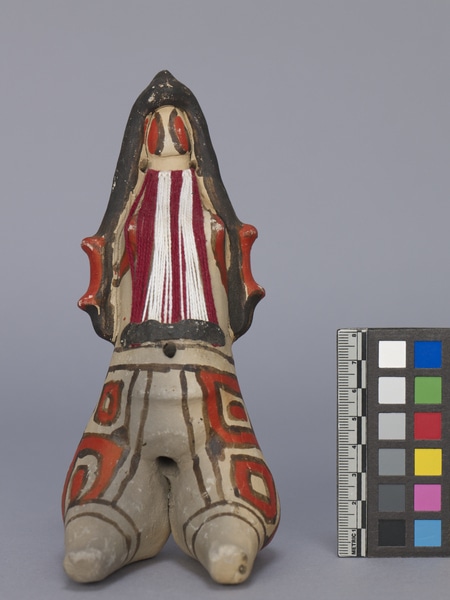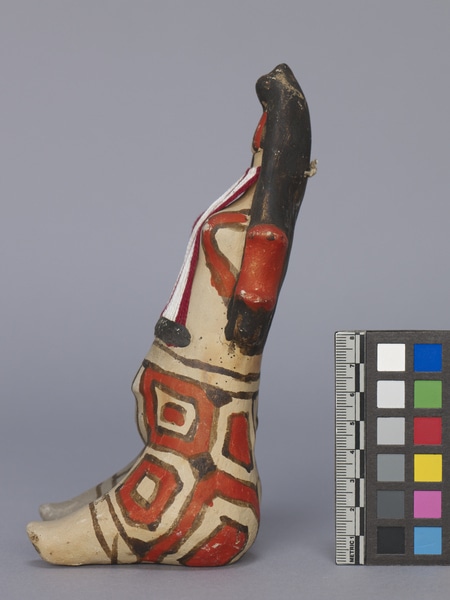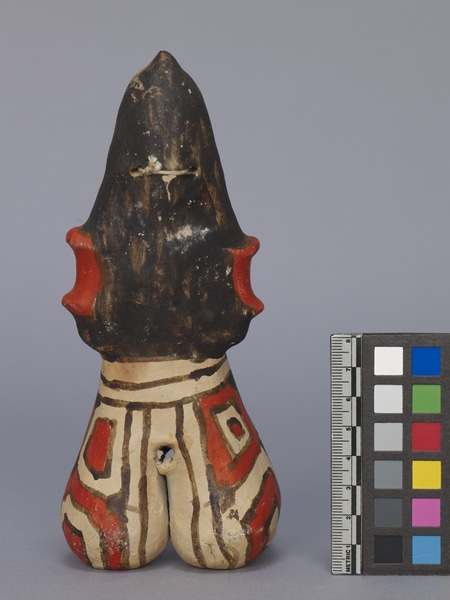Figure Item Number: 3182/23 from the MOA: University of British Columbia




Description
Ceramic ritxoko doll. Figure in the shape of a sitting woman has two thick, short legs extending outward, a prominent stomach, long torso, breasts, and a small featureless face. Thick, heavy brown hair comes to a point above the forehead and falls down the back and sides past the shoulders. Large concave orange beads are added to the hair at the sides. A fringe of red and white wool falls down the figure’s front, attached to a string that passes through holes bored into either side of the neck. A large hole is bored through the pelvis front to back, and another partially through the stomach. Figure is painted with square designs in orange and dark brown.
History Of Use
The Iny (formerly known as Karajá) are known for their ceramics. Only elder women make ritxoko clay dolls, which are now an important source of income as well as a source of subjective and symbolic inspiration to redress the wounds of violent colonial occupation. Iny society is organized around extended families of three or four generations. There is a deep divide between male and female practices. As they approach puberty, young girls are offered a set of ritxoko clay dolls to play with. These represent a family and include both boys and girls of various ages. Contemporary production includes both modern and old styles. The modern style is more realistic while the old style is less complex technically, with the arms placed close to the body in female figures, for instance, and signified only by shoulders in male figures. Both old and modern painting styles are highly conventional and replicate the complex body painting the Iny use to signify status from cradle to grave. The Karajá dolls "Ritxòkò" were declared intangible cultural heritage of Brazil in 2012.
Specific Techniques
Chest decoration in cotton threads and beeswax. Black pigment is created by mixing jenipapo fruit (Genipa americana) with coal, and red from the seeds of the shrub urucum (Bixa orellana).
Iconographic Meaning
This figure represents an young woman in her teens, of marriageable age. She is made in the older style (arms close to the body), in a seated position.
Cultural Context
When the various Iny groups were first contacted by Europeans in the 18th century their total population was estimated to be around 9,000. Persecution and slavery led to a precipitous decline, and by the early 20th century less than 600 individuals were left, facing possible extinction. As part of the “developmental” policies of successive Brazilian governments, their lands were occupied by cattle grazers and industrial farmers, and their rivers exploited for commercial fishing. But against the odds the Iny have prospered, and by 2014 their population had rebounded to about 4,000 people.
Item History
- Made in Ilha do Bananal, Tocantins, Brazil during 2015
- Collected by Nuno Porto during October 2015
- Owned by Nuno Porto before June 20, 2016
- Received from Nuno Porto (Seller) and Museum of Anthropology Exhibitions Budget (Funding source) on June 20, 2016
What
- Name
- Figure
- Identification Number
- 3182/23
- Type of Item
- figure
- Material
- clay, paint and wool fibre
- Overall
- height 18.5 cm, width 7.8 cm, depth 10.0 cm
Who
- Culture
- Iny
- Field Collector
- Nuno Porto
- Previous Owner
- Nuno Porto
- Received from
- Nuno Porto (Seller) and Museum of Anthropology Exhibitions Budget (Funding source)
Where
- Holding Institution
- MOA: University of British Columbia
- Made in
- Ilha do Bananal, Tocantins, Brazil
When
- Creation Date
- during 2015
- Collection Date
- during October 2015
- Ownership Date
- before June 20, 2016
- Acquisition Date
- on June 20, 2016
Other
- Item Classes
- ceramics
- Condition
- good
- Accession Number
- 3182/0023